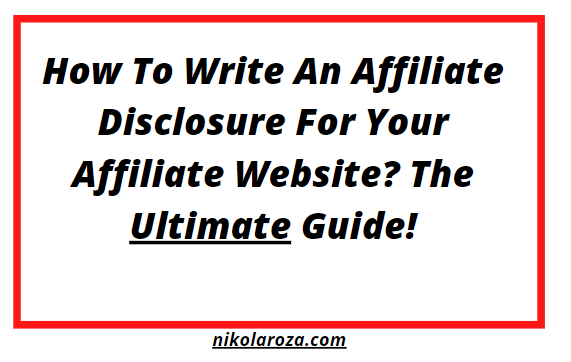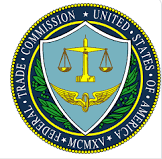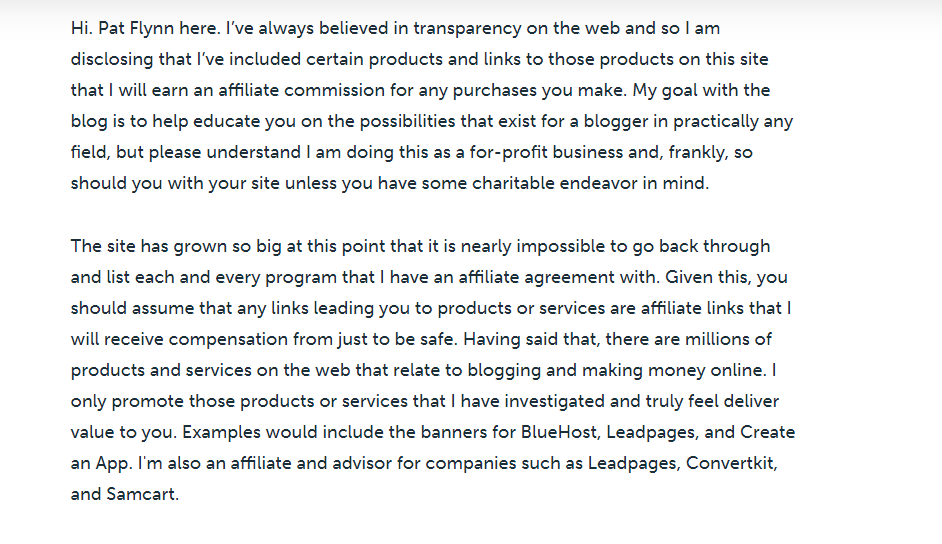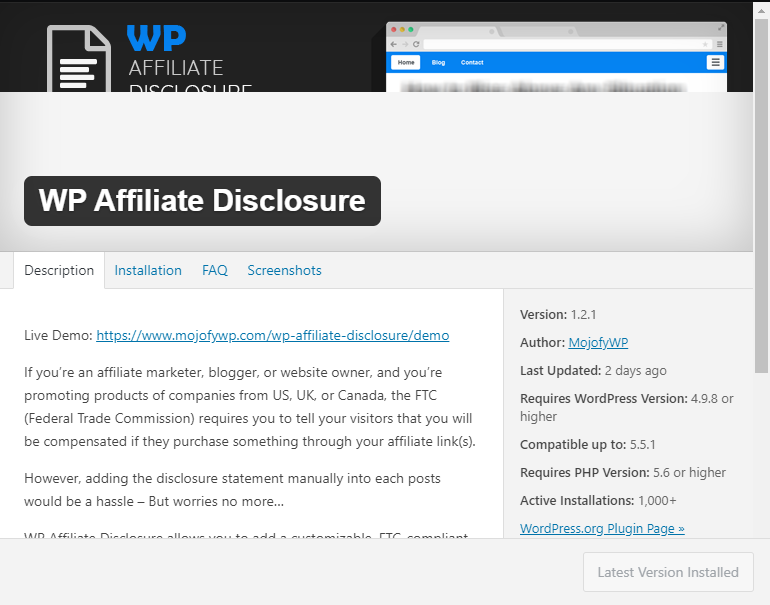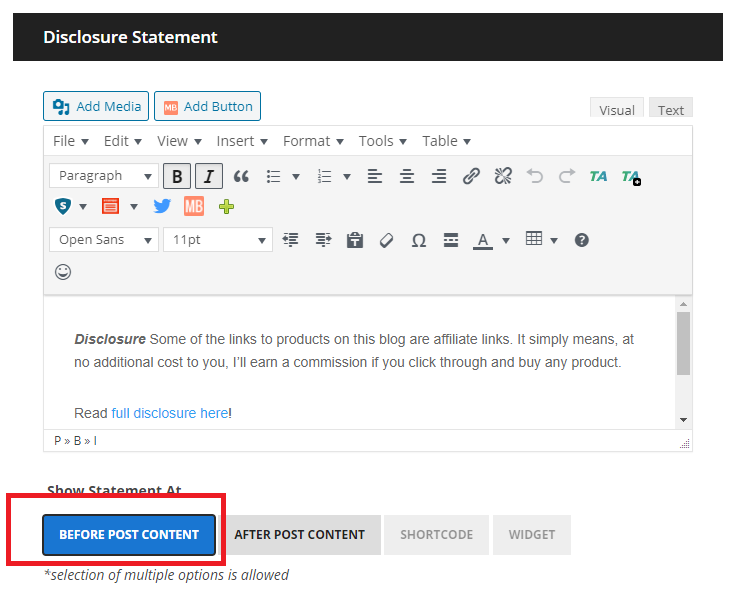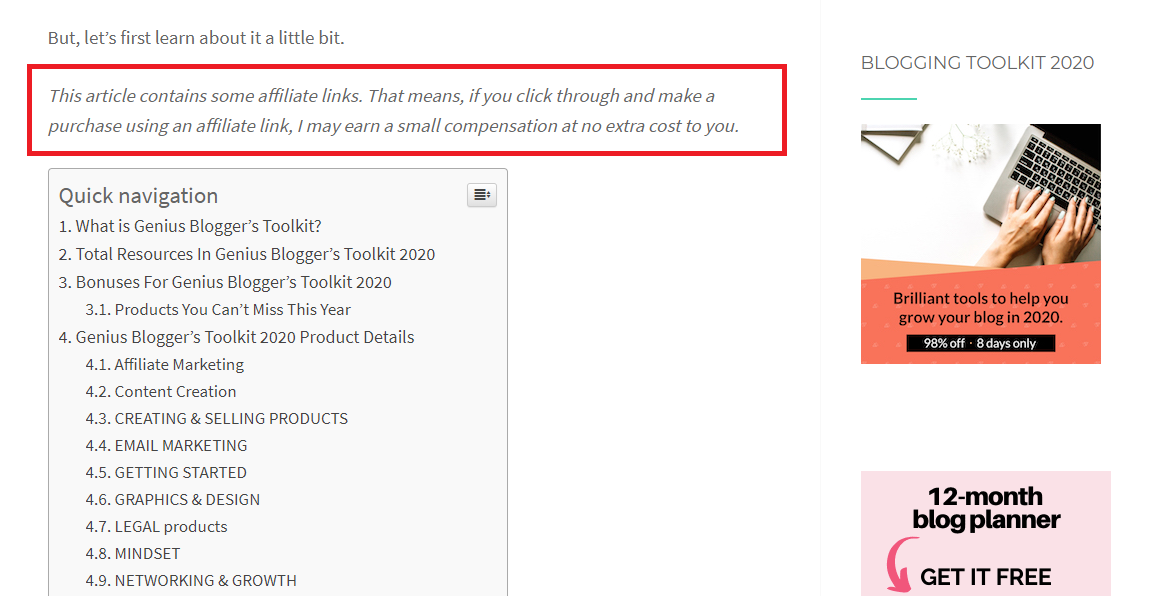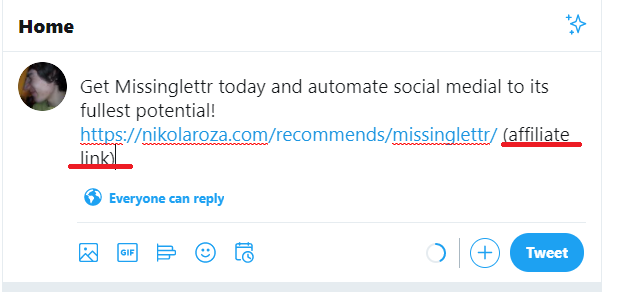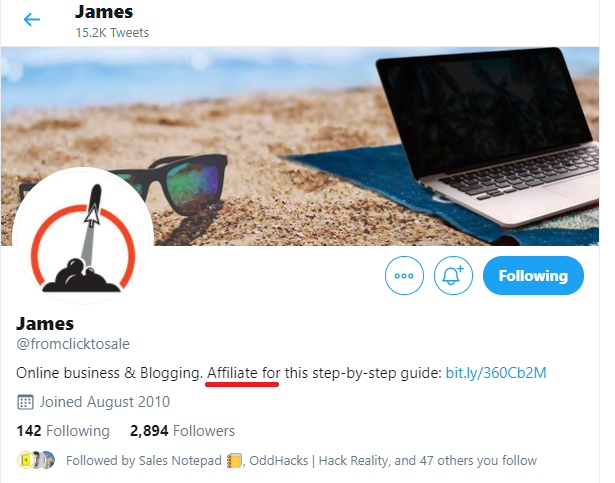Disclosure: Some of the links you’ll encounter are affiliate links. If you click and buy something, I’ll get a commission. If you’re reading a review of some precious metals company, please understand that some of the links are affiliate links that help me pay my bills and write about what I love with no extra cost to you. Thank you!
Here you will learn what an affiliate disclosure is, and how to write one for your WordPress site.
If you do affiliate marketing, then this is a must-read post for you.
So let’s get started right away.
Table of Contents
What is an Affiliate Disclosure? And 3 Reasons Why You Need To Have It On Every Post Of Your Blog
Affiliate disclosures are short text blurbs present on all pages on your site that host affiliate links.
Their purpose is to explain to your site’s visitors what affiliate marketing is, and how you’re compensated for recommending certain products and services. You also need to explain to them you’re ethically collecting their data for marketing purposes, and that they can opt out at all times if they wish.
Here are 3 reasons why you need to include affiliate disclosures in all your blog posts.
#1- You’re Required By Law
FTC (Federal Trade Commission) requires you to write and post a disclosure where you explain how you profit from recommending certain products to your audience.
Failure to do it can get you severe monetary fines at best, and shut down of your entire business at worst.
#2- You Build Trust With Your Audience
Your readers are not stupid and they know you probably don’t write content purely out of the goodness of your heart.
They can guess there’s money involved and by letting them know their hunch was spot on, you show them your respect.
And in turn they’ll buy more because they’ll trust your product recommendations more.
Ironic, no?
#3- Be a Proper Marketer
Purposely not writing or hiding an FTC disclosure is something only shady marketers would do.
If you want to have a future in affiliate marketing you need to NOT be like them. You should also make sure that you have a contract signed between you and the company you are marketing for before any work begins. The contract stage can be sped up considerably by adding your digital signature online to save contracts being sent back and forth between parties.
How To Write A Simple (Yet Effective) Affiliate Disclosure
Writing an affiliate disclosure sound complicated, but it’s actually a cinch and anyone can do it.
Heck, you can even copy it from some other blogger if it’s short enough not to cause any duplicate content issues.
Here are 4 golden tips to write a solid affiliate disclosure today.
#1- Length
Affiliate disclosure can and should be succinct and to the point. Don’t go on a tangent. Keep it simple, clear concise and maximum 5 sentences long.
Your goal is to convey as clearly as possible that you’re getting paid for some of your recommendations.
Note: you will see some great examples further down this post, so stay tuned.
Pro tip– affiliate disclosure within your posts should be succinct, but you can go all out on a dedicated disclosure page.
For example, look how Pat Flynn goes into detail explaining his site’s mission and goal, and how it ties into affiliate marketing.
It’s almost like a true blog post.
#2- Simplicity
Pay special attention to your words as you write your affiliate disclosure. You must use normal speak that your visitors use and understand.
And you must avoid fancy words that make you sound smart but your disclaimer text becomes difficult to read and understand.
Also, don’t use marketing jargon and words like PPC, API or ROI.
You can’t assume your reader know what these acronyms mean.
#3- Readability
Your disclosure must be easy to read and distinguishable for the rest of the article. Consider writing it in a different font and prefacing it with the word “disclosure” or “paid advertisement”.
Where To Place Affiliate Disclosure On Your Website?
You must put your affiliate disclosure somewhere where it will be equally visible on both mobile and desktop devices. This means that putting it in your sidebar and footer isn’t enough.
It’s because both sidebar, footer and even navigation get pushed way below the content on mobile display.
Remember, your disclosure must be prominent and unavoidable, regardless of device used to access your site.
Here are your choices below.
#1- Disclosure At The Top Of Blog Posts
Right below the headline and before actual content, your affiliate disclaimer will be unavoidable. And in fact, that is what I do on my review of Augusta Precious Metals (the best gold IRA company in the USA)
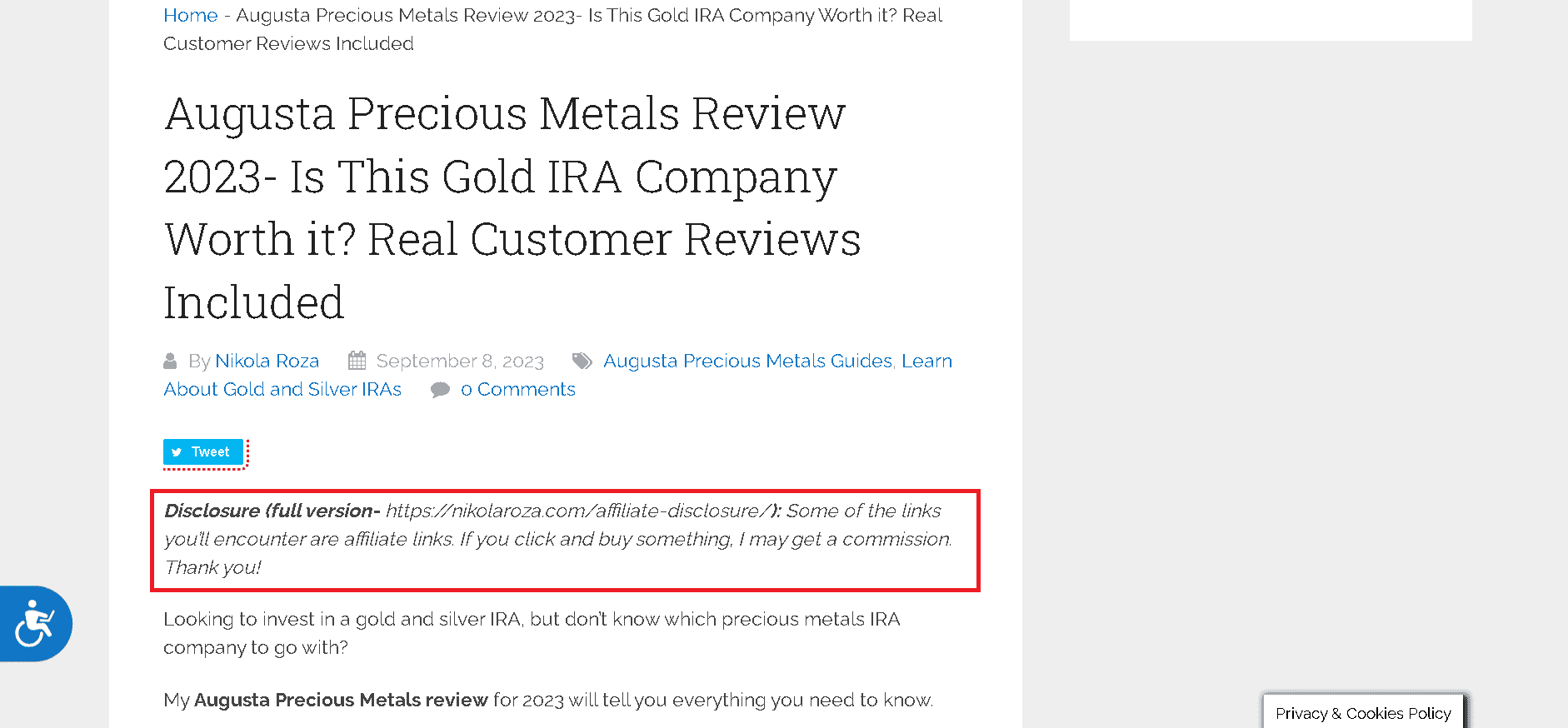
You will also notice that my disclosure links to my disclosure page where I talk in more detail about how I earn from affiliate links.
Note: adding a disclaimer at the top is especially important in niches that are YMYL as in this case are gold IRA and silver IRA.
Investing in gold and precious metals is serious business for most people and they need to know they can trust your objective advice.
#2- Disclosure On a Separate Page
It helps your credibility and it’s a trust factor to have your FTC disclosure somewhere on the site (linked to from the footer is great)
This makes you transparent and honest, and let’s anyone interested easily find it and read it.
Keep in mind that it’s not enough just to have a disclosure page published somewhere on your site.
You also need to have a disclaimer notice on each blog post that has affiliate links, and that disclaimer needs to link to your disclosure page.
#3- Next to Affiliate Links
You can also label your affiliate links by putting mini disclosures in parenthesis next to it.
For example this (affiliate link) is an affiliate link for Fusebox Player (review)
See how I labeled the link in parenthesis?
In my opinion, this is a bit too much and it’s a lot of hassle to label every affiliate link like that.
So the first two ways combined are more than enough 🙂
How To Add Affiliate Disclosure To Your Blog With a WordPress Plugin (Tutorial)
In this quick tutorial, I’ll show you how to add an affiliate disclosure so it shows up on every post and page on your site, so that you won’t ever have to worry about it again.
First, inside your WP dashboard, find and install WP Affiliate Disclosure (free plugin)
Second, find the plugin in the left sidebar of your WP dashboard and click on it.
Third, Click on “Add new Rule” and then write your disclosure in the editor.
Once you’re done set it so that it appears on all posts and pages, and before content.
And that’s it. Piece of cake, I know 🙂
Best Examples of Affiliate Disclosures In Action!
Here are some awesome affiliate disclaimers you can learn from.
#1- BloggingWizard.com
Adam Connell is an affiliate marketing pro and he knows the necessity of affiliate disclosures. So he places one (or rather some WP plugin does it for him) at the end of his every blog post.
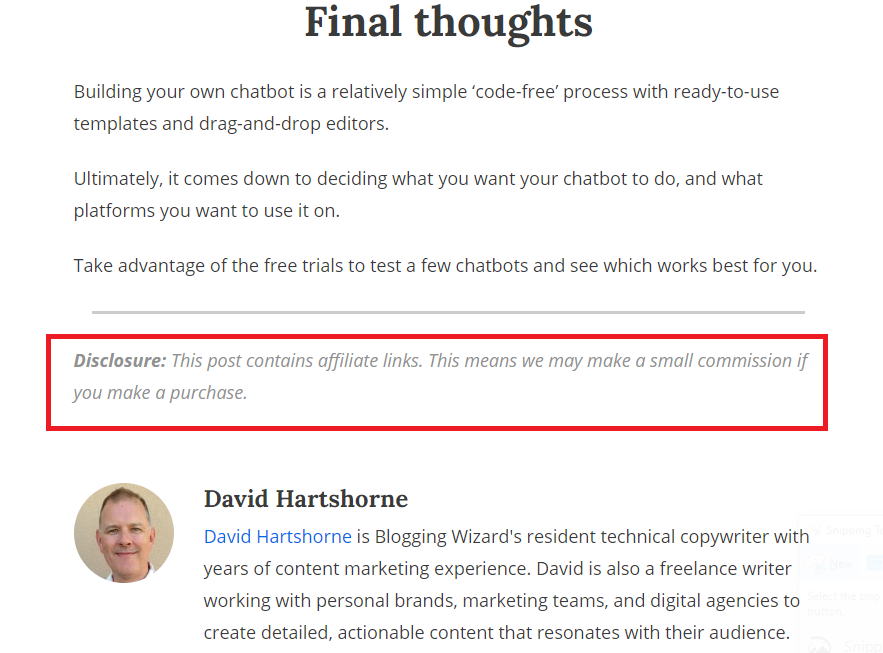
He also has a full disclosure page tucked away in his footer.
That’s an excellent setup
#2- BloggingExplained.com
This is a blog of my good friend Mudassir Ahmed. And his starting a blog guide is the blog post I want to use as an example
Here, you can see Mudassir has his affiliate disclosure link in his theme’s footer.
However, that is not enough. And his blog at the moment I visited it was not FTC compliant. So I sent him a message and he said he didn’t know that just a link in the footer was not enough.
I’m sure if you visit his blogging guide today, you’ll find he has a disclosure inside his blog post too.
Hey, what are friends for? 🙂
#3- SheMeansBlogging.com
This is a blog of my good friend Arfa Nazeer.
She’s also an expert pro blogger and affiliate marketer, and every post on her site has an affiliate disclosure at the top of the page.
Also, there’s a link to full disclaimer in her site’s footer.
[/wps_note]
Bonus #1- How To Add Amazon Affiliate Disclosure For Your Site
For the most part, writing an affiliate disclosure for Amazon affiliate sites is the same as for regular affiliate websites.
However, as per the requirements of Amazon’s Associates Terms, you need to include the following line in your disclosure:
“As an Amazon Associate, I earn from qualifying purchases.”
After you’ve include this line, your job is done. You’re not allowed to talk about your affiliation with Amazon on your website. And you’re especially not allowed to include anything that even suggests Amazon endorses you in any way.
That’ll get you booted out of the program for good.
Bonus #2- How To Disclose Affiliate Links On Social Media
You must disclose affiliate links o social media.
Luckily, it’s very easy to do so.
I’ll use Twitter an as an example
Let’s say I want to send out a tweet promoting Missinglettr review
I’d need to include a disclosure next to that affiliate link.
You can also promote your affiliate link in your Twitter bio.
For example, here’s how James Pierce of fromclicktosale.com does it with his Twitter bio.
Concluding My Writing an Affiliate Disclosure Guide…
Look:
It’s true. Affiliate disclosures are pretty dry topic. But they are a necessity.
You need to have one if you’re going to do ANY affiliate marketing, in a SAFE way.
So why not write your affiliate disclosure right away?
I trust that after reading my ultimate guide- you know how 🙂
Just in case, let’s quickly recap:
If you receive compensation of any kind for affiliate links you post on your blog,then you must:
- Write a clear, easy-to-understand and succinct affiliate disclosure that you will post on every blog post that has affiliate links.
- Create a dedicated disclaimer page where you explain what affiliate marketing is, and how you profit from it.
Do this and you’ll be safe from any kind of penalty, and you will also earn your reader’s trust.
Here’s FTC official document for reference.
Leave me a comment below, let me know what you think.
Thanks!
Nikola Roza
Nikola Roza is a blogger behind Nikola Roza- SEO for the Poor and Determined. He writes for bloggers who don't have huge marketing budget but still want to succeed. Nikola is passionate about precious metals IRAs and how to invest in gold and silver for a safer financial future. Learn about Nikola here.

